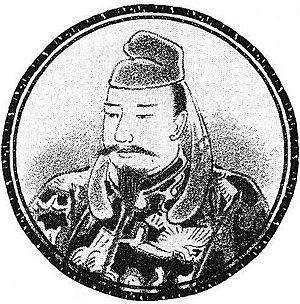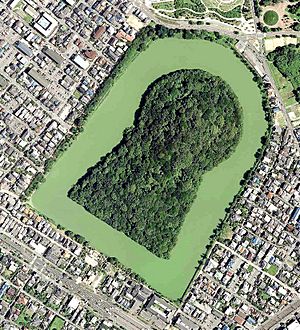Emperor Richū facts for kids
Quick facts for kids Emperor Richū履中天皇 |
|||||
|---|---|---|---|---|---|

Hypothetical depiction of Emperor Richū
|
|||||
| Emperor of Japan | |||||
| Reign | 400–405 (traditional) | ||||
| Predecessor | Nintoku | ||||
| Successor | Hanzei | ||||
| Born | 336 | ||||
| Died | 405 (aged 68–69) | ||||
| Burial | Mozu no Mimihara no Minami no misasagi (百舌鳥耳原南陵) (Osaka) | ||||
| Spouse | Kusakanohatabino-hime | ||||
| Issue among others... |
Ichinobe no Oshiwa | ||||
|
|||||
| House | Imperial House of Japan | ||||
| Father | Emperor Nintoku | ||||
| Mother | Iwano-hime | ||||
| Religion | Shinto | ||||
Emperor Richū (履中天皇 (Richū-tennō)), also known as Ōenoizahowake no Mikoto, was the 17th Emperor of Japan. This is according to the traditional order of succession.
Ancient Japanese history books, the Kojiki and Nihon Shoki, tell us about events from Richū's life. These books are often called the Kiki. Emperor Richū is most famous for a time when his brother, Suminoe, tried to kill him. This happened after their father, Emperor Nintoku, died. Even though we don't have exact dates for his life, people usually say he ruled from 400 to 405 AD.
During his time as emperor, it's said that local record keepers were first put in place across different areas. A royal treasury was also started, and court waitresses, called Uneme, first appeared. Richū had a wife and a concubine, and they had four children together. However, none of his children became emperor. Instead, Richū chose his other brother, Mizuhawake, to be the next ruler. Richū is believed to have died in 405 AD when he was about 70 years old. His brother Mizuhawake became Emperor Hanzei the next year. We don't know the exact spot where Richū is buried. But he is honored at a special Shinto tomb. Historians today believe that Richū was a real person. They also think the name "Emperor Richū" was given to him much later.
Contents
His Story from Ancient Books
Japanese people have always believed that Emperor Richū was a real person. There is even a special burial mound, called a misasagi, kept for him today. Most of what we know about Richū comes from the Kojiki and Nihon Shoki. These are old Japanese books that mix true historical facts with legends and myths. Sometimes, the stories in these books might have been made bigger or changed over time.
These old records say that Richū was born in 336 AD. His mother was Princess Iwa. He was given the name Ōenoizahowake no Mikoto. He was the oldest son of Emperor Nintoku. His father made him the crown prince in 343 AD. When Emperor Nintoku died in 399 AD, there was a time of sadness. After that, a big problem happened that almost cost Richū his life.
A Brother's Plot
Before Richū officially became emperor, he sent his younger brother, Prince Suminoe no Nakatsu, to help with his marriage plans. Suminoe was supposed to arrange things with a woman named Kuro-hime. But Suminoe made a mistake. He left his wrist-bells at Kuro-hime's house.
Later, when Richū visited Kuro-hime, he found the bells. He figured out what his brother had done. But Richū decided not to do anything about it. However, Suminoe was scared of what Richū might do. So, that night, Suminoe planned to kill his brother. He gathered a small group of people. They surrounded Richū's palace. Luckily, some of Richū's loyal helpers saved him. They took him away to safety at Isonokami Shrine. Suminoe then set fire to the palace. He didn't know that Richū had already escaped.
When Richū's other younger brother, Prince Mizuhawake (who later became Emperor Hanzei), heard about the escape, he followed Richū. But Richū told him that he could only be trusted if he proved his loyalty by killing Suminoe. So, Mizuhawake went back to Naniwa. He paid one of Suminoe's helpers to kill him. At that time, Suminoe thought his brother had run away and disappeared. He wasn't ready for an attack. After Suminoe was killed, Richū was very thankful. He gave Mizuhawake some special grain storage buildings.
Emperor Richū's Rule
Richū became emperor in 400 AD, after the rebellion was stopped. During this time, people who had helped in the rebellion were punished. Some were forced to get tattoos. Kurohime was officially made a concubine later that year. Richū and Kurohime had two sons and one daughter. But in 401 AD, Richū chose his brother, Prince Mizuhawake, to be the "Crown Prince" instead of his own children.
In 403 AD, "local recorders" were appointed for the first time in different areas. Their job was to write down important statements and messages from the emperor. In 404 AD, Kurohime died. The reasons for her death are not clear. It's said that the emperor heard a strange voice before a messenger told him she had died. Richū thought her death was because an official had upset a god at a shrine.
In 405 AD, Princess Kusakanohatabino-hime became the empress. They had a daughter named Princess Nakashi. Also in that year, a royal treasury was set up. It was managed by two people from Korea. Emperor Richū's rule ended in its sixth year. He became sick and died at the age of 64 or 70. The old books say Richū was buried in a misasagi on the "Plain of Mozo no Mimi". His brother, Mizuhawake, became the next emperor in 406 AD.
What Historians Know
Historians generally agree that Richū was a real ruler in the early 5th century. Some scholars say he was one of the first Japanese rulers who was not just a legend. Others call his time the "semi-historical period." They also note that rulers from this time onward no longer had unbelievably long reigns.
Some scholars have even suggested that Emperor Richū might be the same person as "King San" mentioned in old Chinese records. These Chinese records say that King San sent messengers to China in 421 and 425 AD.
Historians have different ideas about when local record keepers were first introduced. Some say it happened later than Richū's reign. Others believe that a Korean scholar named Wani brought knowledge of Chinese writings, not just the skill of writing itself. During Richū's rule, court waitresses (Uneme) appeared. Also, storehouses (Kura) were built in different areas. There was also an "Administrator of State Affairs" from his reign onwards. There are different ideas about Richū's exact age when he died, with numbers like 64, 67, 77, 85, and 87 being mentioned.
There is no proof that the title tennō (Emperor) was used during Richū's actual lifetime. It's likely he was a powerful leader or a local clan chief. The area he ruled might have been only a small part of Japan today. He might have been called Sumeramikoto or Amenoshita Shiroshimesu Ōkimi, meaning "the great king who rules all under heaven." Or perhaps "Great King of Yamato." The name Richū-tennō was probably given to him after his death by later generations. This name might have become official centuries after he lived. This was likely when the stories about the beginnings of the Yamato dynasty were put together in the Kojiki.
We don't know the exact place where Richū is buried. But he is traditionally honored at a large, ancient burial mound called a kofun. This kofun is in Sakai, Osaka. The Imperial Household Agency, which manages royal sites, calls this location Richū's official burial place. It is formally named Mozumimihara Minamisagi. It is also known as the Kami Ishizu Misanzai kofun.
The reign of Emperor Kinmei (around 509–571 AD) is the first for which historians have found clear, proven dates. The names and dates of the early emperors were not officially confirmed as "traditional" until the time of Emperor Kanmu, between 737 and 806 AD.
Family and Children
Wives and Concubines
| Position | Name | Father | Children |
|---|---|---|---|
| Concubine | Kuro-hime (黒媛) | Katsuragi no Ashita no Sukune | • Prince Ichinobe no Oshiwa (磐坂市辺押磐皇子) • Prince Mima (御馬皇子) • Princess Aomi no Himemiko (青海皇女) |
| Empress (Kōgō) |
Kusakanohatabino-hime (草香幡梭皇女) | Emperor Ōjin | • Princess Nakashi no Hime (中磯皇女) |
His Children
| Status | Name | Mother | Notes |
|---|---|---|---|
| First Son (Prince) | Ichinobe no Oshiwa (磐坂市辺押磐皇子) | Kuro-hime (黒媛) | Ichinobe was the father of Emperor Kenzō and Emperor Ninken. He is said to have died in 456 AD. |
| Prince | Mima (御馬皇子) | Kuro-hime (黒媛) | Prince Mima is said to have died in 456 AD. |
| Princess | Aomi no Himemiko (青海皇女) | Kuro-hime (黒媛) | Aomi (also called Iitoyo) is believed to have lived from 441 to 484 AD. |
| Princess | Nakashi no Hime (中磯皇女) | Kusakanohatabino (草香幡梭皇女) | Nakashi later married Emperor Ankō. |
See also
 In Spanish: Richū Tennō para niños
In Spanish: Richū Tennō para niños
- Emperor of Japan
- List of Emperors of Japan
- Imperial cult


